|
| 239
|
CHAPTER 38
Osvaldo:
A Triplegic Boy with Many Challenging Needs
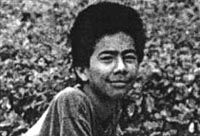
OSVALDO's childhood was like that of many boys in
a poor urban community. He lived with his ailing mother on a hill on the
outskirts of Culiacan, the state capital of Sinaloa, Mexico. His father
had abandoned the family years before. His mother worked in a factory, for
wages so low that sometimes there was little to eat. Osvaldo went to
school, but he often skipped classes to do odd jobs or to play.
When he was 13 years old, an event happened that drastically
changed Osvaldo's life. He was playing with friends on the
roadside outside the family hut, when a truck parked at the top of the
hill, and the driver got out. Then the hand-brake failed, and the truck
rolled down the steep dirt road toward the children at play. It suddenly
pitched off the narrow road, straight into the children. One child was
killed, four were injured. Because the driver had not been in the truck
(and had slipped the police a bribe) he was not held responsible.

After he was hit, Osvaldo - dazed and bleeding - tried to stand up. But
he could not move his legs or his right arm. Neighbors took him to the
hospital. The doctors found his spinal cord was crushed at
mid-back level (T6). He had a double fracture of his right leg,
above and below the knee. His right shoulder was broken and dislocated,
with nerve damage that left his right hand and arm paralyzed.
So it was that, at age 13, Osvaldo became triplegic (paralyzed
in 3 of 4 limbs). He had lost all movement and feeling in his
lower body and had no urine or bowel control. In
the hospital his broken spine was stabilized surgically with metal rods.
(Fortunately, Osvaldo's mother had social security insurance which covered
most of the medical expenses.)
On his release from the hospital, Osvaldo was taken by ambulance to his
home. Unfortunately, neither he nor his mother had been given instructions
about prevention of pressure sores and urinary infections. So, day after
day, Osvaldo lay on his back on a burlap cot without moving. A month
later, when a nurse made a home visit, she found that his back, buttocks,
and heels were covered with pressure sores. The hospital
then provided an "egg crate" foam mattress, and a nurse instructed the
boy's mother to "Turn him frequently from side to side."
But this was easier said than done, as his mother soon discovered.
Osvaldo had sunk into severe depression which expressed itself as
anger, directed mostly at his mother. His paralyzed right hand
was extremely sensitive: it gave him unbearable, burning pain, especially
when it was moved. He rested it over his chest without moving it for weeks
and months. In time, his right arm became stiffly fixed in front of him.
He was so afraid of having his painful hand touched or moved that
he refused to let his mother get near it. Whenever she tried to
move him he would weep and protest. Using his good left arm, he fiercely
fought off her attempts to turn him on his side. Because of his lack of
urine and bowel control, she had a hard time keeping him clean. |
| 240
|
PROJIMO TO THE RESCUE
In November, 1991, on a visit to the capital city, two disabled
workers from PROJIMO learned about Osvaldo and visited his home. Five
months after his accident, the boy was near death. Emaciated, anemic,
and very depressed, he had deep pressure sores, a urinary infection and
chronic fever. His doctors had not stressed the importance of drinking
lots of water to reduce the risk of urinary infection. Adding to the
danger, they had not changed him from a permanent catheter
(urine-draining tube) to intermittent catheterization (see
page 147). His dark urine had so much
crud in it that the catheter often clogged. His pressure sores, which
his mother did her best to clean and bandage, were infected and had
black necrotic (dead) areas.
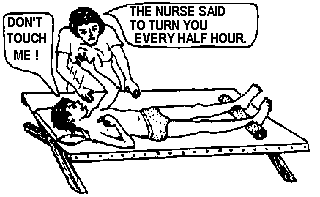
The worst sores were on the back of his ankles. They formed after the
visiting nurse - worried about the sores on his heels - told his mother,
"Keep a rolled-up towel under his ankles." His mother had carefully
followed the nurse's orders. Four months later (when the PROJIMO workers
visited the home) deep sores had formed where the towel was still
obediently positioned. The sore under the left ankle was so deep that it
bared the Achilles tendon.
This was a powerful lesson for the PROJIMO workers. They saw the
danger of simply giving cookbook-like instructions without explanations.
On the contrary, it is important to:
Help people to fully understand the reasons for
doing things, so that they are able to
make well-informed decisions, based on their own observations
and changing needs.
Further complicating Osvaldo's condition was his delicate, often
angry mood, his fear of pain or injury, and the excruciating sensitivity
of his paralyzed right hand. Yielding to his tearful protests, his
mother had given up attempting to turn him onto his side or belly. So,
for five months he had lain on his back, his pressure sores getting
larger and deeper, and his body growing as stiff as a board.
On seeing Osvaldo, the PROJIMO workers felt that - due to the
difficult combination of physical and emotional needs - more might be
accomplished in their small community rehabilitation center than in the
home. They invited him and his mother to spend a while at PROJIMO. At
first, Osvaldo was afraid to leave home ... or even to be moved from his
cot. But the warmth and concern of the PROJIMO workers gave him a new
sense of hope. Gathering courage, he accepted their offer. The next
morning, with Osvaldo lying on a foam mattress in the back of a station
wagon, the group made the 4-hour trip to PROJIMO.
The Need for a Creative and Loving Approach
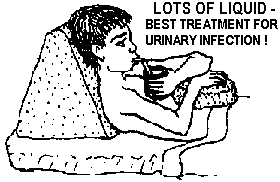 The
complexity of Osvaldo's needs called for very caring rehabilitation and
innovative assistive equipment. His urinary infection and sores required
urgent attention. For the former, the team gave him antibiotics and
encouraged him to drink lots of fluids. However, he
often refused to drink, even when we explained its importance. Since
Osvaldo's favorite drinks were orange juice and hot chocolate, we
pampered him with all of these he could drink. As his urinary infection
got better, so did his mood and appetite. The
complexity of Osvaldo's needs called for very caring rehabilitation and
innovative assistive equipment. His urinary infection and sores required
urgent attention. For the former, the team gave him antibiotics and
encouraged him to drink lots of fluids. However, he
often refused to drink, even when we explained its importance. Since
Osvaldo's favorite drinks were orange juice and hot chocolate, we
pampered him with all of these he could drink. As his urinary infection
got better, so did his mood and appetite.
The team put Osvaldo on a high calorie, high protein, high
iron diet. Improving his nutritional status and blood level
would help to heal his pressure sores, and fight off the urinary
infection.
|
| 241
|
Managing Osvaldo's Pressure Sores - and Lifting His Spirits
The next job was to find a way of taking the pressure off of
Osvaldo's pressure sores. To manage the sores on the back and
buttocks, PROJIMO usually builds a gurney, or trolley (narrow wheeled
bed), on which the person can lie face down. That way he can wheel
himself around, and energetically work and play. Keeping active not
only makes lying face down for long periods more tolerable, but it
also stimulates circulation, which speeds healing.
With Osvaldo, however, lying face down was not an easy matter. From
having lain flat on his back for months, his entire body had become as
stiff as a board. Also, his paralyzed right arm was almost "frozen,"
with his forearm over his chest. Both the shoulder and hand were so
super-sensitive that he would howl even before someone touched them.
The first job was to win Osvaldo's trust and to involve him in the
problem-solving process. The team tried to give him a sense of control
that would help him overcome his fear. Often, it seemed that
his fear of the pain was worse than the pain itself.
Certainly it made the pain worse.
On discussing Osvaldo's wishes and needs with him and his mother,
it became clear that the management of his sores needed an
integrated plan to lift both his body and his spirit. His
various physical and emotional needs needed to be answered in a
"whole-person," or holistic, way. The group agreed that the major
short-term objectives with Osvaldo were:
 | to figure out ways to get the pressure off Osvaldo's sores for
prolonged periods and, as soon as possible, to find a way for him to
lie face down without lying on top of his stiff, hypersensitive
right arm and hand; |
 | to help him regain flexibility of his hips and knees, so that he
could begin to sit: first in bed, and later (after his pressure
sores healed) in a wheelchair; |
 | to correct the foot-drop (contracture of the heel cords) that
had begun to form; |
 | to help him increase the strength and ability of his useful
(left) arm - a greater challenge because he had been right-handed; |
 | to design mobility aids that Osvaldo could move and steer with
only one arm; |
 | to provide a range of enjoyable and useful activities so as to
encourage self-care, self confidence, and more independence; |
 | while doing all of the above, to provide a friendly,
understanding, stimulating, entertaining, and adventurous
environment - to help Osvaldo pull out of his depression and
rediscover joy in life, the will to live, and ability to love. |
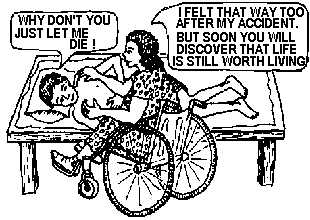
Talking with Osvaldo was not easy. It took time for him to gain
enough confidence in himself and in others to speak seriously. What
seemed to distress him most was his sense of powerlessness and total
immobility. He feared remaining dependent, not being able to do
anything for himself, to move, or to go anywhere without help.
Therefore, helping Osvaldo learn to do more for himself,
manage his personal body functions, and move under his own power
were seen as urgent goals which could contribute to his healing in
many ways.
In these pages, we will not describe all the aspects of Osvaldo's
rehabilitation - rather we will focus on several of the most
innovative aids and activities. |
| 242
|
Innovations For and With Osvaldo
To help meet the various objectives of Osvaldo's rehabilitation -
or revitalization - the PROJIMO team designed a number of innovative
devices. They will be described here in the order in which they were
created and used.
It is important to note that most of these innovations were
developed with the active participation of Osvaldo himself.
In the process, this 13-year-old boy acquired a much clearer
understanding of his body, its unusual needs, and how to meet them. He
began to rediscover and become friendly with his own mysterious body,
and to increasingly take charge of his own rehabilitation and care.
Soon he was reminding and guiding his attendants (especially his
mother) about how to position him and where to place padding to
prevent pressure sores. His testing, criticism, and suggestions for
improvements of devices became a valuable part of the innovative
process. As he became an active participant in the design of his own
equipment, he gained new confidence, lost much of his fear of trying
new things, was less fretful, and gradually became again a friendly,
playful boy - although strangely perceptive and wise for his age. (He
avidly read Disabled Village Children and gave suggestions
for the rehabilitation of other children.)
AN ADJUSTABLE BED
- To help reduce pressure over sores, bend his stiff body, and prepare
him for sitting
Complexity of the problem: Clearly, for
rapid healing of his pressure sores, Osvaldo needed to stop lying on
his back and start lying on his belly or side. However, the team
realized the need to move toward this slowly, at a pace the boy could
tolerate and control. Osvaldo was terrified of being shifted to a new
position that might trigger the pain in his hypersensitive shoulder
and hand. It had taken his last bit of courage just to come to
PROJIMO, and the team did not want to push him too hard or fast. In
the first days, especially, it was essential that his experience at
PROJIMO be as reassuring and uplifting as possible. Therefore the
team, together with Osvaldo and his mother, tried to think of ways to
reduce the pressure on the sores on his back and buttocks - and to
help him regain some flexibility in his hips and knees - while still
lying face up.
Partial solution: To reduce pressure over
the bony areas with sores, Osvaldo was laid on a double foam
mattress, the lower one thick and fairly firm, the upper one
quite soft. To help speed healing, the sores were packed daily with a
paste made of bees' honey and sugar (see
page 156).
From lying flat on his back for so long, Osvaldo's hips and knees
had grown so stiff (with extension contractures) that they almost
would not bend at all. Bending exercises were introduced. What was
needed, however, was prolonged, very gentle stretching. It would have
helped to have a hospital bed that could be gradually cranked up into
a sitting position, slowly bending the hips and knees. But such a
costly item was out of the question.
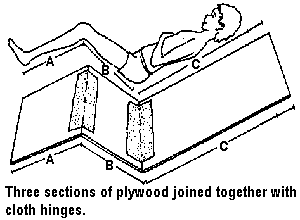
Partial solution: an adjustable, hinged plywood bed board.
Materials: 1 sheet plywood; 2 strips old cloth (about 6
inches wide); white glue.
Construction: A piece of plywood the size of the cot was
cut in three pieces based on Osvaldo's body measurements (A=feet to
knees, B=knees to hips, C=hips to head). The plywood sections were
then joined together with cloth hinges made with strips of old towel
and white glue. |
| 243
|
|


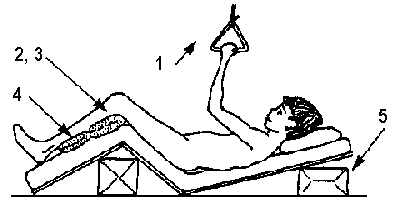
- A metal triangle, hanging from a rope over Osvaldo's bed,
allowed him to lift himself up periodically with his good arm.
This took pressure off his back, and also helped strengthen his
arm.
- By putting padding under Osvaldo's knees, some of the weight
could be taken off his backside.
- This padding reduced the pressure on his buttocks and lower
back, where he had some of his worst sores.
- Padding was also placed under his lower legs, to take pressure
off his heels and ankles.
- By putting boxes of different sizes under the bed-boards, the
angle of his hips and knees could gradually be increased.
Results: Flexibility of Osvaldo's body
returned surprisingly quickly. Within a few weeks, both his hips and
knees flexed to almost to 90 degrees. Also, being able to move into
a partly sitting position allowed the boy to do more things more
easily (eat, read, draw pictures, and take part in what was going on
around him). His disposition improved accordingly. And his pressure
sores began to heal.

Technical problem: With repeated
removal and replacement of the hinged plywood bed-board between the
two foam mattresses, the cloth hinges began to tear loose.
Solution:hinges made of thin cord. As
an experimental alternative, hinges were made using cord (thick
string). The cord passes through small holes in the edges of the
plywood sections.
Results of cord hinges: These hinges
were as quick and easy to make as the cloth hinges, and they could
be used at once (whereas several hours of drying time were needed
before the cloth-and-glue hinges could be used). The cord hinges are
stronger and hold up longer than the cloth hinges (although this
clearly depends on the relative strength of the cord, the cloth, and
the glue). |
| 244
|
A SIMPLE AID FOR ACTIVE CORRECTION AND PREVENTION OF FOOT-DROP,
IN BED
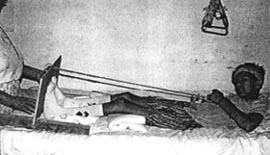
The problem: From lying in bed so long,
Osvaldo had begun to develop contractures of his heel cords
(Achilles tendons). This made it difficult to bring his feet up to
90 degrees. He wanted to do this with the dream of someday standing
or even walking - or at least so his feet would be in a good
position and he could wear shoes.
Osvaldo wondered if there was some way he could do the exercises
by himself to regain the flexibility of his ankles.
The solution: a flexible foot-board pulled by a rope.
Materials: a short piece of thin wood plank; 2 narrow
boards about 2 cm. by 6 cm. by 60 cm. long; a piece of rope (about 1
meter); a piece of dense rubber foam (to cushion the feet).
Construction: Notch wood, drill hole, and assemble as
shown.
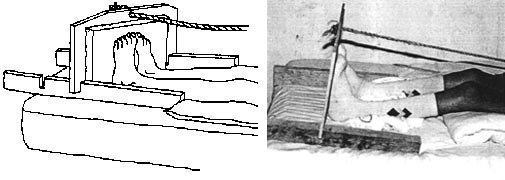
How it works: The footboard is placed
to keep the feet upright (as near to 90 degrees as possible). For
his heel-cord stretching exercises, Osvaldo pulled the rope himself.
As Osvaldo pulls the rope, the front ends of the side boards sink
into the foam mattress, angling the footboard forward and stretching
the feet (and heel-cords).
Results: The device worked fairly well.
The hinge-like action, which allowed the foofboard to angle forward
more when pulled, was unplanned and recognized only when tried. The
device actively involved Osvaldo in exercises to correct and prevent
further contractures of his ankles. Moreover, to do the exercises,
he had to move his upper body and shoulders somewhat, which he had
resisted doing because of his hypersensitive right arm. So the foot
exercises were also good therapy for his painful shoulder and arm. |
| 245
|
AN ADJUSTABLE BED TABLE

The problem: Osvaldo, who before his
accident had been right-handed, needed to develop confidence and
skill in using his left hand. He also needed activities to keep him
interested and busy during the long periods of lying in a flat or
semi-sitting position. For this, he needed a table which could
easily be rolled over his bed, and which could adjust both in slant
and in height. The group decided that a wooden design, which any
village carpenter could make, would be ideal.
Solution: Two of the workers in the
carpentry shop (Mario, who is paraplegic, and Rafa, who is
quadriplegic) designed and built the wooden table shown below.

 | Small bolts with butterfly nuts for adjusting height. |
 | Table pivots on bolt passing through curved groove. |
 | Butterfly nuts for adjusting angle. |
 | Wooden wheels allow bed table to be easily rolled into place,
yet provide enough friction for stability. |
 | Wooden bar keeps objects from slipping when table is tilted.
The bar is attached with wooden rods (dowels) and can be removed
when table is flat - for eating, etc. |
Results: The table was handsome,
strong, and it worked well. It was large and solid enough to double
as a drafting table. It could also be used as a typing or work table
by someone in a wheelchair. This model can be easily made or adapted
by a local carpenter. Wooden wheels help keep the cost down. The
only welding necessary was to fasten the "wings" on the butterfly
nuts. (Ordinary nuts and bolts would work as well, but require a
wrench.) For transport, the wing nuts can be removed and the whole
table packed flat.
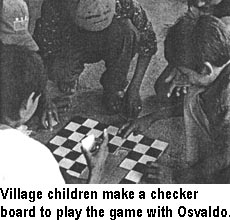
The adjustable bed table made it easier for Osvaldo to do many
activities in bed. He took particular pleasure in drawing. He began
to confront the challenge of learning to draw and write with his
left hand.
Games. Some of the school children who came to
visit Osvaldo made a checker board for him. While
playing such games with other children, often the sign of a smile
would creep over Osvaldo's face.
The main disadvantage of the table was its heavy weight and bulky
size (as compared to the welded commercial hospital bed-tables that
roll in from one side of the bed).
|
| 246 |
GURNEY (NARROW WHEELED BED) WITH ONE-HAND DRIVE

Problem: To heal his pressure sores,
Osvaldo needed to lie face-down for long periods. However, his
paralyzed right arm was stiffly contracted over his chest. The arm
was so hyper-sensitive that it would take a long time with therapy
to regain enough flexibility to place it out of the way so that he
could lie face down.
Another problem was how to help Osvaldo
regain flexibility (bending ability) of his hips and knees while
lying face down. A special gurney could be built for him with
adjustable angles at the hips and knees. Actively moving about on
the gurney would also stimulate circulation and thereby speed
healing of the pressure sores.
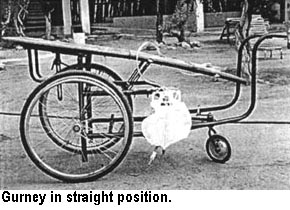
But the biggest problem was: How could
Osvaldo wheel and steer a gurney with one hand?
Solution: A one-hand-drive gurney with
adjustable hip and knee angles, and with a cut-out section and
lower-level table for his paralyzed arm.
A rectangle was cut out of the bed of the gurney at the level of
Osvaldo's right shoulder, so his stiff arm could rest on a small,
cushioned table underneath.


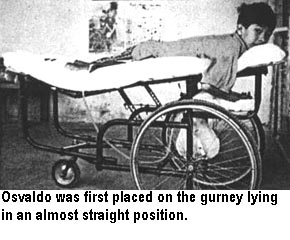
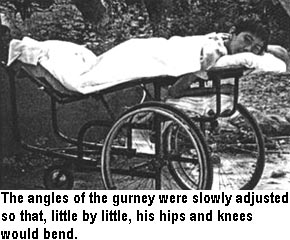
|
| 247
|
The steering device for the one-arm-drive gurney
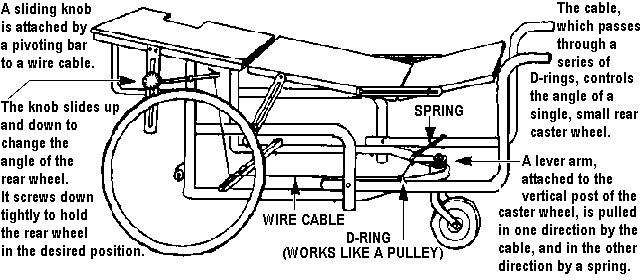
 | A sliding knob is attached by a pivoting bar to a wire cable. |
 | The knob slides up and down to change the angle of the rear
wheel. It screws down tightly to hold the rear wheel in the
desired position. |
 | The cable, which passes through a series of D-rings, controls
the angle of a single, small rear caster wheel. |
 | A lever arm, attached to the vertical post of the caster
wheel, is pulled in one direction by the cable, and in the other
direction by a spring. |
To move straight ahead, Osvaldo tightens the
steering knob to hold the rear wheel straight, and rolls the gurney
by pushing the hand rim of the left big wheel. To make a
turn, he quickly loosens the knob, slides it up or down to
angle the caster wheel either to the left or right, and again locks
the knob in place. The turn completed, he again moves the knob and
locks it in the straight-forward position.
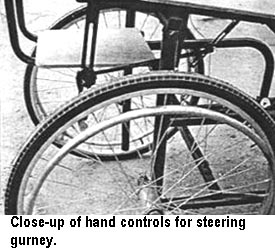
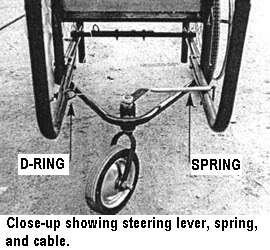
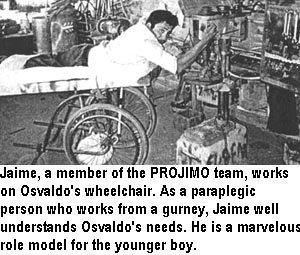
Results: Although it had certain
problems and limitations, the gurney was a great success for
Osvaldo. Through repeated experimentation, and a flood of complaints
and suggestions by Osvaldo, the steering mechanism was gradually
improved.
At first, too much force was required to make a right turn, and
only a very wide turn was possible. But, by placing the D-ring
(pulley) nearest the caster further back to provide a pull at closer
to 90 degrees, sharper turns could be made, and made more easily.
Also, at Osvaldo's insistence, a rack was added on the front of the
gurney to hold a large bottle of water (see
page 197). This request by Osvaldo
reflected his growing interest in making sure he drank enough
liquids to avoid further urinary infections. |
| 248
|
| At first it was very difficult to
place Osvaldo on the gurney and to position his hyper-sensitive arm
without hurting him. But after a few days, the arm began to get a
little more limber and the boy learned to help position both himself
and his arm. Once in position, he was soon able to stay comfortably
on the gurney for hours. As the angles of the gurney at Osvaldo's
hips and knees were gradually increased, the flexibility of his
joints improved rapidly. Osvaldo soon began to spend much of the
time on the gurney with his hips fairly straight and his knees bent
up. The elevated position of his feet helped to prevent them from
swelling. This, in turn, helped his ankle sores to heal.
In summary:
| The gurney contributed to Osvaldo's rehabilitation
in a wide variety of ways:

 | It helped to heal his sores by removing the pressure on
them (by his lying face down). Also, his energetic activity
on the gurney improved his circulation, which helped the
sores to heal faster. |
 | It protected his hypersensitive right hand by supporting
it on a pillow below his body. But at the same time, his
activity on the gurney caused some movement of his delicate
arm and hand. He tolerated this because his mind was on
other things and he was having a good time. Gradually his
hand became less sensitive, so that he cautiously began to
move it, to wash it himself, and to gently do exercises to
get back flexibility. (Although the hand remained paralyzed,
some strength returned in his shoulder, and eventually he
started using it as a helping hand.) |
 | The hinged bed of the gurney helped to correct the
extension contractures of his hips and knees, by gradually
increasing the bend of its jointed sections. |
 | With its one-arm drive, the gurney allowed him the
freedom of self-controlled and self-powered mobility. This
greatly improved his outlook on life and on himself. |
 | Elevating his feet by flexing the hinge at his knees
improved the circulation and decreased the swelling of his
feet. (This speeded the healing of the deep sores on his
ankles.) |
 | By encouraging physical activity and more drinking of
water, the gurney helped to prevent urinary infection and
kidney stones. |
 | Wheeling himself around on the gurney helped to
strengthen his more useful arm, providing therapy that was
both functional and fun. |
 | Altogether, the gurney gave him new self-confidence and
improved his state of mind. His greater happiness was due
partly to being able to go where he liked under his own
power, and partly to his participation in designing and
improving his own equipment. |
 | The role model of other disabled persons who ride and
work on gurneys helped a lot. |
|
|
| 249
|
A ONE-ARM-DRIVE WHEELCHAIR
Once Osvaldo's pressure sores had healed and he regained enough
flexibility so that he could sit, he needed a one-hand-drive
wheelchair.
The problem: Hemiplegic (one-hand
drive) wheelchairs are manufactured commercially in the United
States and in other rich countries. But they are very expensive and
are usually not available in poor countries. Also, the drive
mechanism is relatively complex and tends to break down quickly on
rough terrain. (The problems with these commercial one-arm-drive
wheelchairs are further discussed in
Chapter 39.)
Occasionally, PROJIMO has a second-hand hemiplegic wheelchair
donated from the cooperating hospitals and programs in the United
States. But at the time Osvaldo needed one, none was available.
Solution: Like many rehabilitation
programs in the Third World, PROJIMO has a big need for an
easy-to-build, low-cost, hemiplegic wheelchair. It occurred to the
workers in the shop that the same front-wheel steering mechanism
used for Osvaldo's gurney might work for a wheelchair.

Through a lot of trials and suggestions by Osvaldo, a design was
created.
A single front caster was controlled by pulleys and cable to a
steering knob mounted on a vertical bracket on the left side of the
chair.
Trial construction, trouble-shooting, and improvements.
In the early design, the very small D-rings (improvised front
pulleys) gave too much resistance and made steering difficult.
In the modified design, larger, smoother-running pulleys were
used. This made steering easier.
Pulling on the lock-knob required too much force for Osvaldo
(whose back was still painful). Therefore a longer lever-arm was
added. |
| 250
|
Design details of Osvaldo's wheelchalr:

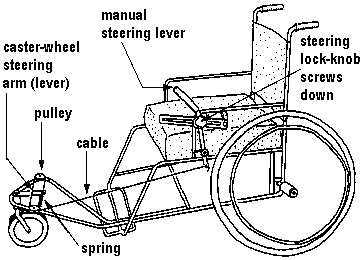
Results:
After several modifications to make steering easier, Osvaldo
found the chair very useful. He learned to steer it with remarkable
agility and became relatively independent. The strength in his left
arm increased. The removable arm rest on the right side, plus the
easy access for his feet, made putting him in and out of the chair
relatively simple. He soon learned to help with the transfers, using
his left arm.
One disadvantage of this design is its lengthy forward extension
to support the steering wheel. This makes moving about in close
quarters more difficult (although far less so than the
front-wheel-drive tricycles with a bicycle wheel at the front, which
are even longer and more cumbersome). On the positive side, the
narrowness of the "nose" of Osvaldo's chair, and the small front
wheel, make moving about in close quarters somewhat easier.
In conclusion, the Osvaldo one-hand-drive wheelchair provided a
relatively low-cost, easily constructed option in situations where
standard hemiplegic chairs are seldom available, too costly, and not
durable. Although to our knowledge this new wheelchair has not yet
been duplicated, we feel it has the potential to help fill the
enormous unmet need of hemiplegic wheelchair riders in low-income
situations. However, the design still needs to be simplified and
improved. One possibility might be to shorten the forward extension
to make it easier to move about indoors.
For another, better design of a one-arm
wheelchair, see the next chapter (page
253). |
| 251
|
Summary of the Combined Methods of Managing Osvaldo's
Pressure Sores
Following his accident Osvaldo lay on his back for 5 months
without being turned. When he came to PROJIMO he had 11 pressure
sores, extending from mid back to his heels. The largest sores were
2 to 3 inches across. Most were fairly shallow (bone not exposed)
and his mother had kept them fairly clean. However, there was some
dead as well as unhealthy gray tissue on the surface of the sores.
The deepest sore, about 2 inches long, was over the heel cord
(Achilles tendon) of his left foot; the tendon was exposed.
Complicating treatment of Osvaldo's pressure sores was his
hypersensitive paralyzed right arm, which had become rigidly
contracted over his chest. This stiff, painful arm prevented him
from lying either face down, or on his right side.
SIX STEPS TAKEN TO PROMOTE HEALING OF OSVALDO'S
PRESSURE SORES:
|
| 1. Minimize pressure over the sores while
lying down. This was done by:

 | Putting cushions under his legs to take pressure
off his buttocks, lower back, and ankles/heels. |
 | Providing a ring so he could lift himself up. |
 | Using a thick sponge mattress. |
|
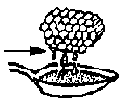
2. Adequate cleaning of the sores; treatment
with sugar and honey.
|

3. Wheeled mobility while lying face down,
with the feet up (until the sores heal).
4. Lots of activity to speed up circulation,
which causes faster healing.
|

5. Food rich in calories, protein, and iron
to strengthen the body and blood, to speed healing.
|
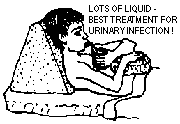
6. Management of the boy's overall health,
especially his urinary system.
|
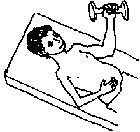
7. Strengthening the good arm and increasing
his ability to change his position.
|
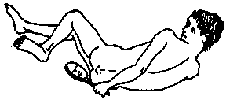
8. Encourage the boy's understanding and
responsibility in healing and preventing pressure sores:
above all, changing position and lifting up the body
often. |
|
|
| 252
|
MEDICAL TREATMENT OF OSVALDO'S PRESSURE SORES
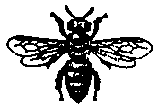
Treatment involved daily washings, at first
brisk enough to remove dead flesh. Once the healthy red flesh was
exposed, cleansing became quite gentle so as to avoid damage to the
newly forming tissues. After cleaning the sores, a paste of
bees' honey mixed with sugar was applied to the sores and
covered lightly with gauze (see page 156).
Results: With this treatment program,
combined with the management techniques reviewed on
page 251, the sores healed remarkably fast. Even the deep sore
over Osvaldo's heel healed in 3 weeks. The team feels it was the
combined actions of treatment and management that led to rapid
healing. Surely the change in Osvaldo's attitude made a big
difference. He began to oversee and take responsibility for his own
care, advising his mother and other attendants about how to place
padding to relieve pressure over bony areas, and asking to be turned
or moved after a time in one position. His increased physical
activity also probably contributed to his quick healing, as did the
many hours he spent each day lying face-down on his specially
designed gurney.
| Comparison of PROJIMO's methods with hospital
treatment of Osvaldo's pressure sores. The steel
rods surgically placed in Osvaldo's back after his accident came
loose, and had begun to poke through the skin. To remove the
rods, Osvaldo was taken to an orthopedic hospital in California.
During the 2-day drive, a new small pressure sore formed over
his sacrum (bottom part of the spine). In the hospital,
Duoderm (a costly, medicated, absorbent bandage) was put
over the sore, and Osvaldo was placed in bed for 24 hours a day.
He lay on his back on a special air-flow mattress run by an
electric air-pump, so that the pressure over each small area of
the body was constantly changing. In the hospital, with all
this costly treatment and equipment, the boy in his space-age
bed was deprived of all choice or responsibility for his own
care. His pressure sore - smaller and more superficial than ones
that had healed in 3 weeks at PROJIMO - took over 2 months to
heal.
Ironically, from lying flat on his back for so long in the
hospital, Osvaldo's knees and hips were again becoming rigid. A
physiotherapist, attempting to restore flexibility, used too
much force and broke his right leg. With his leg in a cast for
weeks, a new deep pressure sore formed on his right heel. Again,
it took over 2 months to heal. During all these months in the
hospital, Osvaldo's anger, hostility, and depression - which he
had gradually been overcoming - re-emerged. The nurses were at a
loss for knowing how to get him to cooperate. |
COMPARISON OF HEALING TIME OF SIMILAR PRESSURE SORES ON
OSVALDO'S BACKSIDE
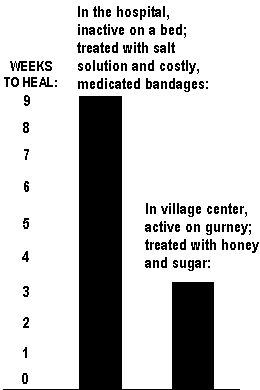
|
Comparing results of Osvaldo's management at PROJIMO with those
at this modern orthopedic hospital, it appears that the
comprehensive, action-oriented, whole-person approach used
at the village center was relatively successful - at least for the
healing rate of pressure sores. The rapid healing, achieved with
Osvaldo's sores has occurred with many (but not all) persons
attended at PROJIMO. More comparative study is needed.
|
|